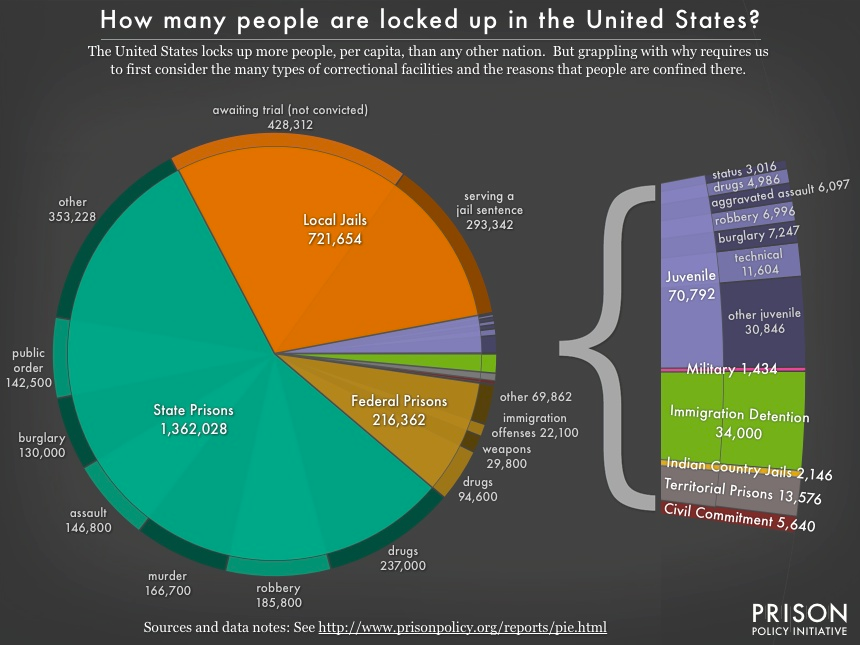Prison Overcrowding Threatens Public Safety and State Budgets
Audrey Williams
How many people are actually locked up in the United States? Well, as it turns out, it’s hard to say. Inconsistent and fragmentary data has made piecing together the “whole pie” of U.S. federal, state, local and other types of confinement data difficult. Lucky for us, the Prison Policy Initiative has released a comprehensive graphic that aggregates the available information and helps to explain the complicated and expansive U.S. correctional system.

From the collected data, the Initiative found that the incarceration system in this country “hold[s] more than 2.4 million people in 1,719 state prisons, 102 federal prisons, 2,259 juvenile correctional facilities, 3,283 local jails, and 79 Indian Country jails as well as in military prisons, immigration detention facilities, civil commitment centers, and prisons in the U.S. territories.”[1] This total distinguishes the United States with the highest incarcerated population in the world.
Of course, not all of those people stay in prison. Annually, 688,000 people are released from state and federal prisons back into society. This number adds to the almost 12 million people who cycle through local jails each year, revealing an “enormous jail churn.”[2] As the above graphic indicates, a contributing factor to this massive and steady churn in jails is the nearly 430,000 people who at any given moment are occupying local cells awaiting trial and conviction. The rest are being held for minor offenses with sentences under a year. (Note: While probationers and parolees might also be included in the jail churn, it is important to note that this data excludes probation/parole figures.)
The data also exposes disturbing realities about juvenile detention. For example, as the study reports, “there are almost 15,000 children behind bars whose “most serious offense” wasn’t anything that most people would consider a crime.”[3] Here’s the breakdown: almost 12,000 children are confined for “technical violations,” or infringements related to their probation or parole and over 3,000 children are behind bars for “status” offenses, which are, “behaviors that are not law violations for adults, such as running away, truancy, and incorrigibility,” as the U.S. Department of Justice explains.
The Prison Policy Initiative has, indeed, given us the “whole pie”—ipso facto altering the original question. Rather than asking “how many people are locked up,” the question has become “does it really make sense to be imprisoning this many people?”
Implicated in this new question are serious economic and individual liberty concerns, including the overemphasis on incarceration for nonviolent, low-level offenses and the subsequent (read: massive) corrections spending among states. Annually, each inmate costs taxpayers approximately $31,286, on average. It’s important to note that these massive incarceration numbers are higher than necessary to protect public safety. In 2006, a study from the State of Washington found that while incarcerating chronic, violent offenders does provide a net public benefit by protecting public safety and controlling crime, increased use of imprisonment for nonviolent offenders leads to negative returns. This, as seen in ALEC’s recently updated initiative on Prison Overcrowding, has led states pouring hundreds of millions, even billions, of taxpayer dollars into their corrections budget. Prisons serve a valid and necessary role in protecting our communities but locking up many nonviolent individuals for lengthy sentences is an avoidable bill for taxpayers to foot.
To help state policymakers protect public safety while responding to budget demands, ALEC members have crafted model policies that draw on proven practices to help control crime and budgets in states. These policies redirect nonviolent offenders from prison to successful evidence-based programs, provide for victim restitution and facilitate a positive reintroduction of offenders into society. The Recidivism Reduction Act, Swift and Certain Sanctions Act, and Earned Compliance Credit Act, among other ALEC corrections and reentry model policies, ensure costly prison cells and strict penalties are reserved for violent and predatory offenders. These reforms can help states protect their communities while giving taxpayers the best public safety return on investment.
For more information on mass incarceration, corrections and reentry, prison overcrowding and criminal justice visit the American Legislative Exchange Council’s updated Prison Overcrowding Initiative.
Footnotes
[1] Wagner, Peter and Sakala, Leah. Mass Incarceration: The Whole Pie. http://www.prisonpolicy.org/reports/pie.html
[2] Ibid.
[3] Ibid.
